Philippine Warty Pig
Common Name: Philippine Warty Pig
Scientific Name: Sus philippensis
Habitat
The Philippine Warty Pig is primarily found in the dense forests and tropical rainforests of the Philippines, particularly on the islands of Mindanao, Palawan, and the Sulu Archipelago. These pigs thrive in areas with thick underbrush, which provide cover and a rich diversity of food resources. They are often located in primary and secondary forests, as well as agricultural areas adjacent to their natural habitats.
Physical Characteristics
The Philippine Warty Pig exhibits unique physical traits that set it apart from other pig species. Adults typically weigh between 50 to 70 kilograms and measure approximately 1 meter in length. They have a distinctive appearance with prominent facial warts, especially in males, which are used for display and combat. Their fur varies in color from dark brown to black with a coarse texture, and they have a sparse bristled coat that can provide camouflage within their forest habitat.
Behavior
Philippine Warty Pigs are predominantly nocturnal, showing heightened activity during the night when they forage for food. They are social animals, often forming small groups of up to 15 individuals, which are usually led by a dominant female. Communication among group members is conveyed through a combination of vocalizations and body language. During the day, they typically rest in shaded areas to escape the heat.
Diet
The diet of the Philippine Warty Pig is omnivorous, primarily consisting of roots, tubers, fruits, and various plant materials. They are also known to consume small animals and carrion when available. Their feeding habits significantly contribute to seed dispersal and the overall health of their ecosystem, as they help maintain vegetation diversity.
Reproduction
Reproduction in Philippine Warty Pigs usually occurs throughout the year, with a peak breeding season during the wet season. After a gestation period of about four months, females typically give birth to a litter of 2 to 4 piglets. The piglets are weaned after approximately 2 months and remain with their mother for up to a year, learning crucial survival skills along the way.
Conservation Status
The Philippine Warty Pig is currently classified as “Endangered” by the IUCN Red List. Its population is declining due to habitat loss, hunting, and competition with domestic pigs. Conservation efforts are vital to protect this unique species from extinction and ensure the stability of its natural habitats.
Interesting Facts
– Philippine Warty Pigs are among the few wild pig species that exhibit significant sexual dimorphism, with males typically being larger than females.
– The warts on their faces are not only for display but also serve a functional purpose during fights, providing protection against injuries.
Role in Ecosystem
As a key species within their habitat, Philippine Warty Pigs play a critical role in the ecosystem. They contribute to the dispersal of seeds through their foraging habits, facilitating the growth of various plant species. Additionally, their activities help aerate the soil and promote a healthier ecosystem by mixing organic matter.
